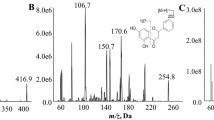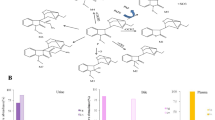Abstract
Paeoniflorin-6′-O-benzene sulfonate (code: CP-25) is a novel ester derivative of paeoniflorin (Pae). Compared to Pae, CP-25 has higher lipid solubility, bioavailability and better bioactivity. However, the tissue distribution and excretion of CP-25 still remain unknown. The LC–MS method was applied to investigate the tissue distribution and excretion of CP-25 in rats. As such, 50 mg/kg of CP-25 and Pae were administered to rats in multiple doses via an oral route. CP-25 and Pae were distributed widely and rapidly in all the tested tissues. Compared with Pae, the concentrations of CP-25 were almost increased evidently in most tissues. The highest CP-25 level was found in the liver (1476.33 ± 535.20 ng/g, male; 1970.38 ± 177.21 ng/g, female) at 3 h, and a high concentration of CP-25 was detected in male and female intestine, synovium, muscle, lung, and brain. Following a single oral dose of 50 mg/kg of CP-25 in rats, the total excretion of CP-25 was merely 21.8% (18.40, 3.19 and 0.22% for feces, bile and urine, respectively) in males; and was approximately 21.3% (14.04, 7.16 and 0.14% for feces, bile and urine, respectively) in females. The results indicated that the CP-25 concentration was higher in major tissues than Pae; CP-25 was primarily excreted through the feces; and there were gender-related differences in the tissue distribution and excretion.



Similar content being viewed by others
References
Almazroo OA, Miah MK, Venkataramanan R (2017) Drug metabolism in the liver. Clin Liver Dis 21:1–20
Anderson GD (2005) Sex and racial differences in pharmacological response: where is the evidence? Pharmacogenetics, pharmacokinetics, and pharmacodynamics. J Womens Health (Larchmt) 14(1):19–29
Anderson GD (2008) Gender differences in pharmacological response. Int Rev Neurobiol 83:1–10
Chang Y, Wei W, Zhang L, Xu HM (2009) Effects and mechanisms of total glucosides of paeony on synoviocytes activities in rat collagen-induced arthritis. J Ethnopharmacol 121:43–48
Chang Y, Zhang L, Wang C, Jia XY, Wei W (2011) Paeoniflorin inhibits function of synoviocytes pretreated by rIL-1α and regulates EP4 receptor expression. J Ethnopharmacol 137:1275–1282
Chang Y, Jia X, Wei F et al (2016) CP-25, a novel compound, protects against autoimmune arthritis by modulating immune mediators of inflammation and bone damage. Sci Rep 6:26239
Chen JY, Wu HX, Chen Y et al (2012) Paeoniflorin inhibits proliferation of fibroblast-like synoviocytes through suppressing G-protein-coupled receptor kinase 2. Planta Med 78:665–671
Demyanets S, Wojta J (2012) Sex differences in effects and use of anti-inflammatory drugs. Handb Exp Pharmacol 214:443–472
Fei F, Yang H, Peng Y et al (2016) Sensitive analysis and pharmacokinetic study of the isomers paeoniflorin and albiflorin after oral administration of total glucosides of white paeony capsule in rats. J Chromatogr B Analyt Technol Biomed Life Sci 1022:30–37
Jia XY, Chang Y, Sun XJ et al (2014) Total glucosides of paeony inhibit the proliferation of fibroblast-like synoviocytes through the regulation of G proteins in rats with collagen-induced arthritis. Int Immunopharmacol 18:1–6
Jia XY, Wei F, Sun XJ et al (2016) CP-25 attenuates the inflammatory response of fibroblast-like synoviocytes co-cultured with BAFF-activated CD4 + T cells. J Ethnopharmacol 189:194–201
Li Y, Sheng K, Chen J et al (2015) Regulation of PGE2 signaling pathways and TNF-alpha signaling pathways on the function of bone marrow-derived dendritic cells and the effects of CP-25. Eur J Pharmacol 769:8–21
Liu ZQ, Zhou H, Liu L et al (2005) Influence of co-administrated sinomenine on pharmacokinetic fate of paeoniflorin in unrestrained conscious rats. J Ethnopharmacol 99:61–67
Liu ZQ, Jiang ZH, Liu L, Hu M (2006) Mechanisms responsible for poor oral bioavailability of paeoniflorin: role of intestinal disposition and interactions with sinomenine. Pharm Res 23:2768–2780
Soldin OP, Mattison DR (2009) Sex differences in pharmacokinetics and pharmacodynamics. Clin Pharmacokinet 48(3):143–157
Wang C, Yuan J, Yang ZY, Nie XX, Song LH, Wei W (2012) Pharmacokinetics of paeoniflorin microemulsion after repeated dosing in rats with adjuvant arthritis. Pharmazie 67:997–1001
Wang C, Yuan J, Zhang LL, Wei W (2016) Pharmacokinetic comparisons of Paeoniflorin and Paeoniflorin-6′O-benzene sulfonate in rats via different routes of administration. Xenobiotica 46:1142–1150
Wu H, Wei W, Song L, Zhang L, Chen Y, Hu X (2007) Paeoniflorin induced immune tolerance of mesenteric lymph node lymphocytes via enhancing beta 2-adrenergic receptor desensitization in rats with adjuvant arthritis. Int Immunopharmacol 7:662–673
Xu HM, Wei W, Jia XY, Chang Y, Zhang L (2007) Effects and mechanisms of total glucosides of paeony on adjuvant arthritis in rats. J Ethnopharmacol 109:442–448
Yang XD, Wang C, Zhou P et al (2016) Absorption characteristic of paeoniflorin-6′-Obenzene sulfonate (CP-25) in in situ single-pass intestinal perfusion in rats. Xenobiotica 46:775–783
Yu J, Xiao F, Asenso J et al (2016) Simultaneous determination of paeoniflorin-60-Obenzene sulfonate (CP-25) and its active paeoniflorin (Pae) metabolite in rat plasma using UPLC-MS/MS: an application for pharmacokinetic studies. RSC Adv 6:113209
Zhang LL, Wei W, Wang NP et al (2008) Paeoniflorin suppresses inflammatory mediator production and regulates G protein-coupled signaling in fibroblast-like synoviocytes of collagen induced arthritic rats. Inflamm Res 57:388–395
Zhang F, Shu JL, Li Y et al (2017a) CP-25, a Novel Anti-inflammatory and Immunomodulatory Drug, Inhibits the Functions of Activated Human B Cells through Regulating BAFF and TNF-alpha Signaling and Comparative Efficacy with Biological Agent. Front Pharmacol 8:933
Zhang H, Qi Y, Yuan Y et al (2017b) Paeoniflorin ameliorates experimental autoimmune encephalomyelitis via inhibition of dendritic cell function and Th17 cell differentiation. Sci Rep 7:41887
Zheng YQ, Wei W (2005) Total glucosides of paeony suppresses adjuvant arthritis in rats and intervenes cytokine-signaling between different types of synoviocytes. Int Immunopharmacol 5:1560–1573
Zheng YQ, Wei W, Zhu L, Liu JX (2007) Effects and mechanisms of Paeoniflorin, a bioactive glucoside from paeony root, on adjuvant arthritis in rats. Inflamm Res 56:182–188
Zhu L, Wei W, Zheng YQ, Jia XY (2005) Effects and mechanisms of total glucosides of paeony on joint damage in rat collagen induced arthritis. Inflamm Res 54:211–220
Acknowledgements
The authors thank the Anhui Collaborative Innovation Center of Anti-inflammatory and Immune Medicine for providing the experimental conditions. This work was financially supported by the National Natural Science Foundation of China (No. 81330081, No. 81302845), the Training Program of Academic and Technical Leaders in Universities of Anhui Province (No. 34), and the Scientific Research Foundation of the Institute for Translational Medicine of Anhui Province (No.2017zhyx33).
Author information
Authors and Affiliations
Corresponding authors
Ethics declarations
Conflict of interest
The authors declare that they have no competing interests.
Rights and permissions
About this article
Cite this article
Zhao, M., Zhou, P., Yu, J. et al. The tissue distribution and excretion study of paeoniflorin-6′-O-benzene sulfonate (CP-25) in rats. Inflammopharmacol 27, 969–974 (2019). https://doi.org/10.1007/s10787-018-0463-3
Received:
Accepted:
Published:
Issue Date:
DOI: https://doi.org/10.1007/s10787-018-0463-3




